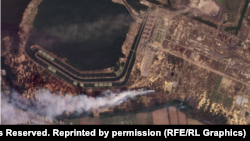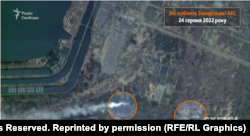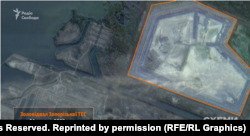Satellite images obtained by Schemes, the investigative unit of RFE/RL’s Ukrainian Service, show fires burning near the Russian-controlled Zaporizhzhya nuclear power plant a day before the flames prompted Ukrainian authorities on August 25 to disconnect the plant, Europe’s largest nuclear power facility, from the country’s electricity grid.
In the satellite images, recorded by the U.S.-based company Planet Labs on August 24, smoke rises in a plume over the ash pit of the Zaporizhzhya thermal power plant, a coal-fueled power station to the east of the nuclear power plant, as well as over sites in a forest not far from the nuclear power plant.
Satellite images from August 25 also show smoke in the area. Neither set of images clarifies how these locations caught on fire, nor as of what date.
On August 25, after the fires damaged power lines that connect the Zaporizhzhya nuclear power station to the Ukrainian power grid, Ukrainian state energy company Enerhoatom disconnected the plant’s two remaining working reactors for the first time in the facility’s nearly 40-year history.
Both reactors at Zaporizhzhya were reconnected to the grid as of 9:15 p.m. local time on August 26, acccording to Enerhoatom. The official statement did not mention whether the fires had been entirely extinguished.
With international alarm mounting over a potential nuclear accident, inspectors from the International Atomic Energy Agency (IAEA) are likely to visit the nuclear power station early next week, possibly on August 29, The Wall Street Journal reported, citing unidentified people close to diplomatic negotiations.
Ukraine and Russia have blamed each other for shelling in the area that places the plant and nearby populations at risk.
On August 25, Ukrainian President Volodymyr Zelenskiy urged the international community to take steps to remove Russian forces from the nuclear power plant. The facility has been under Russian control since March 4, eight days after Russia launched a large-scale invasion of Ukraine in February 24.
Alleging ongoing Ukrainian firing on the Zaporizhzhya plant, Russian Foreign Ministry spokeswoman Maria Zakharova said without evidence on August 26 that the Ukrainian government is seeking to prevent an IAEA visit.
Ukrainian military intelligence claims that Russian shelling had set the radioactive ash sites near the Zaporizhzhya thermal power station ablaze as of August 23.
The Ukrainian Defense Ministry’s Main Intelligence Directorate (GUR) charged on August 23 that the alleged attacks were intended “to manipulate public opinion and influence the world community” to blame the Ukrainian armed forces for an increase in radiation near the nuclear power plant.
The ash, which turns to dust when it dries, carries a level of radiation at least 2 1/2 times higher than that of the surrounding environment, the GUR stated. Wind can blow that dust into the vicinity of Enerhodar, a Russian-occupied city on the Dnieper River that neighbors the Zaporizhzhya nuclear power plant.
On August 26, however, the region’s senior Ukrainian-government physician, Taras Tyshchenko, stated that radiation levels for Enerhodar, the regional capital, Zaporizhzhya, which remains under Ukrainian control Ukraine, and several other sites throughout the Zaporizhzhya region, remain at normal, pre-war levels – 0.07 to 0.13 microsieverts per day.
Before Russia’s February 24 invasion, Enerhodar had a population of under 54,000.











